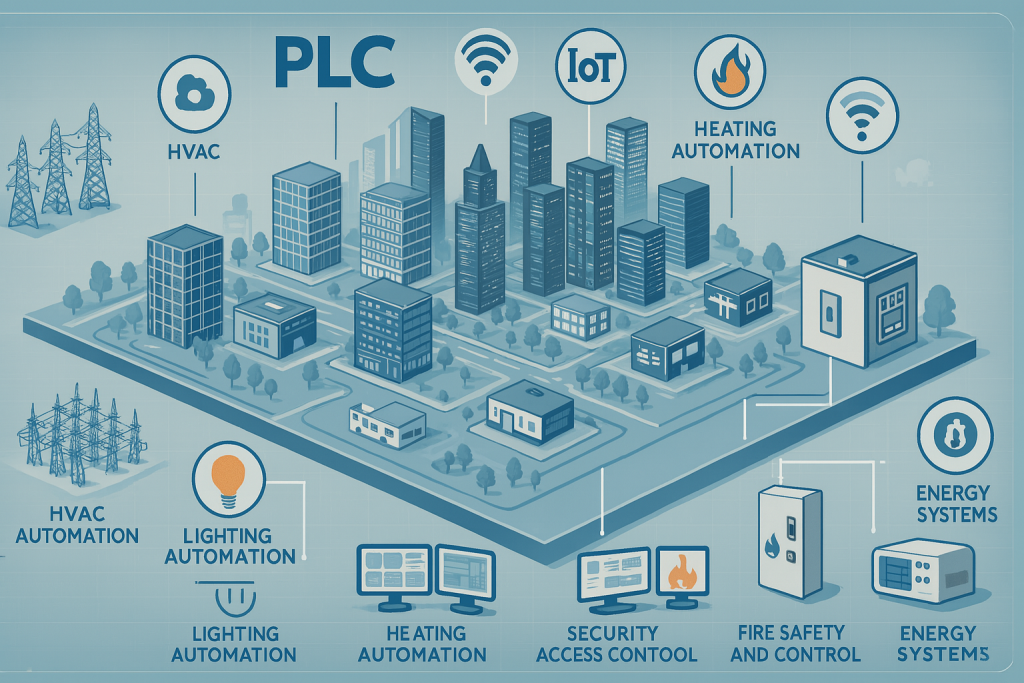PLC Applications in Building Automation
Building automation is a critical aspect of modern infrastructure, helping businesses, residential complexes, and commercial buildings optimize energy use, improve security, and enhance occupant comfort. Programmable Logic Controllers (PLCs) play a vital role in managing and automating building systems, reducing manual intervention and operational costs.

This page explores how PLCs are used in building automation, key applications, benefits, and future trends in smart buildings.
1. What is Building Automation?
A. Understanding Building Automation Systems (BAS)
Building automation refers to the centralized control of a building’s systems, including:
- HVAC – Heating, Ventilation, and Air Conditioning
- Lighting Control – Adjusting lighting based on occupancy and daylight
- Security and Access Control – Managing doors, alarms, and surveillance
- Energy Management – Reducing power consumption
- Fire and Safety Systems – Monitoring emergency equipment and response
Example: In a large corporate office, a PLC-based system automatically adjusts HVAC settings based on occupancy, reducing energy waste.
B. Why Use PLCs in Building Automation?
PLCs provide real-time automation and data-driven optimization for various building systems.
Advantages of PLCs in Building Automation:
- Energy Savings – Minimizes wastage via smart control
- Enhanced Security – Integrates with access and surveillance systems
- Remote Monitoring – Enables control from any location
- Customizable & Scalable – Suitable for buildings of all sizes
- Improved Comfort – Maintains optimal indoor climate
Example: A smart hotel uses PLC-controlled lighting to automatically dim lights in vacant rooms, cutting electricity usage.
2. Key Applications of PLCs in Building Automation
A. HVAC Control
PLCs manage heating, cooling, and ventilation to create a comfortable indoor environment.
PLC-Controlled HVAC Functions:
- Monitoring temperature and humidity sensors
- Adjusting heating and air conditioning dynamically
- Controlling airflow and ventilation for better air quality
Example: In a hospital, PLCs regulate air filtration to ensure clean and safe air for patients.
B. Lighting Automation
PLCs optimize lighting based on occupancy, time, and daylight.
How PLCs Control Lighting:
- Motion Sensors – Turn lights on/off based on presence
- Daylight Sensors – Adjust brightness depending on natural light
- Scheduled Timers – Automate on/off cycles
Example: In a shopping mall, lights dim during non-peak hours to save electricity.
C. Security and Access Control
PLCs are integrated into building security systems, automating access and surveillance.
PLC-Controlled Security Features:
- Automated door locks for restricted zones
- Control of surveillance camera feeds
- Intrusion detection and alarm triggers
Example: In a data center, PLCs manage biometric scanners to restrict access.
D. Fire & Life Safety Systems
PLCs enable timely response in fire and life-threatening situations.
Fire Safety Applications:
- Monitoring smoke and temperature sensors
- Activating sprinkler systems automatically
- Unlocking emergency exits
Example: In a high-rise building, PLCs trigger evacuation fans and alarms during fire incidents.
E. Energy Management & Smart Metering
PLCs help optimize power consumption and prevent energy losses.
Energy Efficiency Functions:
- Real-time monitoring of electricity usage
- Controlling high-energy devices during peak hours
- Load balancing to avoid power surges
Example: A university campus uses PLCs to shut off AC in empty classrooms.
3. Real-World Examples of PLCs in Building Automation
A. Smart Office Buildings
Modern offices use PLCs to manage HVAC and lighting, enhancing comfort and reducing costs.
Example: A corporate headquarters adjusts indoor climate based on employee presence using IoT-integrated PLCs.
B. Smart Homes & Residential Complexes
PLCs enhance home security, climate control, and energy savings.
Example: A luxury apartment uses PLCs to automatically lower blinds when sunlight is intense, reducing AC usage.
C. Airports and Transport Hubs
PLCs coordinate large-scale operations in airports including security and transport systems.
Example: An international airport uses PLCs to manage escalators and walkway belts efficiently.
4. Future Trends in PLC-Based Building Automation
- IoT Integration – Smart sensors and cloud data for intelligent decision-making
- AI-Driven Control – Predictive adjustments to lighting and HVAC
- Wireless PLC Networks – Simplified installations in large buildings
- Sustainable Green Buildings – Lowering environmental impact with optimized energy use
- Remote Management – Controlling systems via smartphones or tablets
Example: A smart city project uses AI-enhanced PLCs to manage street lights and energy flow dynamically.
5. Benefits of Using PLCs in Building Automation
- Cost Savings – Reduced energy bills
- Improved Comfort – Maintains optimal indoor conditions automatically
- Enhanced Security – Controlled access and real-time alerts
- Lower Maintenance – Preventive monitoring reduces failures
- Smart Adaptability – PLCs adjust systems as needs evolve
Example: A sports stadium uses PLCs to adjust lighting levels based on natural sunlight during matches.
Conclusion
PLCs are revolutionizing building automation, making infrastructures more energy-efficient, secure, and adaptive. With advancements in IoT, AI, and smart energy solutions, PLC-controlled buildings are becoming the foundation of sustainable smart cities.
Key Takeaways:
- PLCs control HVAC, lighting, security, energy, and fire systems
- They reduce energy costs and improve safety and comfort
- Future smart buildings will rely on AI-enabled PLCs and IoT connectivity
